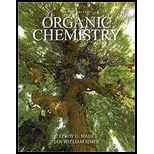
(a)
Interpretation:
The major product of the given reaction and the structure of any intermediate are to be predicted.
Concept introduction:
Substitution reactions are the reactions in which there is a replacement of an atom or a
Elimination reactions are the reaction in which
(a)
Answer to Problem 8.46SP
The structure of an intermediate is shown in Figure 1.
The major product of the given reaction is shown in Figure 2.
Explanation of Solution
When
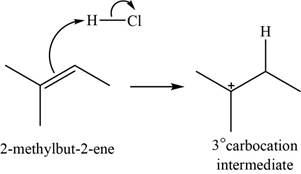
Figure 1
The chloride ion acts as a nucleophile that attacks on the electrophilic tertiary carbocation and results in the formation of
The major product of the given reaction is,
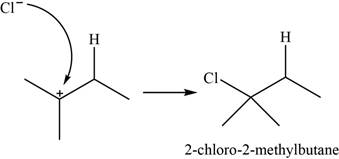
Figure 2
(b)
Interpretation:
The major product of the given reaction and the structure of any intermediate are to be predicted.
Concept introduction:
Substitution reactions are the reactions in which there is a replacement of an atom or a functional group by another atom or a functional group.
Elimination reactions are the reaction in which alkenes are prepared. In this two substituents are eliminated by either one step or two step mechanism.
(b)
Answer to Problem 8.46SP
The structure of an intermediate is shown in Figure 3.
The major product of the given reaction is shown in Figure 4.
Explanation of Solution
When

Figure 3
Bromide ion opens the bromonium ion intermediate at the more substituted carbon atom and forms
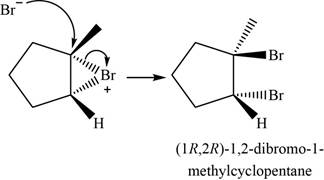
Figure 4
(c)
Interpretation:
The major product of the given reaction and the structure of any intermediate are to be predicted.
Concept introduction:
Substitution reactions are the reactions in which there is a replacement of an atom or a functional group by another atom or a functional group.
Elimination reactions are the reaction in which alkenes are prepared. In this two substituents are eliminated by either one step or two step mechanism.
(c)
Answer to Problem 8.46SP
The structure of an intermediate is shown in Figure 5.
The major product of the given reaction is shown in Figure 6.
Explanation of Solution
When

Figure 5
When
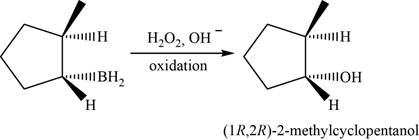
Figure 6
(d)
Interpretation:
The major product of the given reaction and the structure of any intermediate are to be predicted.
Concept introduction:
Substitution reactions are the reactions in which there is a replacement of an atom or a functional group by another atom or a functional group.
Elimination reactions are the reaction in which alkenes are prepared. In this two substituents are eliminated by either one step or two step mechanism.
(d)
Answer to Problem 8.46SP
The structure of an intermediate is shown in Figure 7.
The major product of the given reaction is shown in Figure 8.
Explanation of Solution
When

Figure 7
Now, the ozonide intermediate reacts with dimethyl sulfide and forms acetaldehyde and

Figure 8
(e)
Interpretation:
The major product of the given reaction and the structure of any intermediate are to be predicted.
Concept introduction:
Substitution reactions are the reactions in which there is a replacement of an atom or a functional group by another atom or a functional group.
Elimination reactions are the reaction in which alkenes are prepared. In this two substituents are eliminated by either one step or two step mechanism.
(e)
Answer to Problem 8.46SP
The major product of the given reaction is shown in Figure 9.
Explanation of Solution
When alkene reacts with
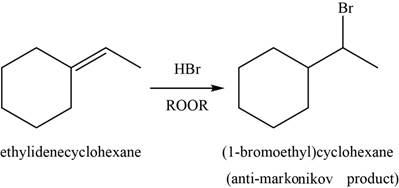
Figure 9
(f)
Interpretation:
The major product of the given reaction and the structure of any intermediate are to be predicted.
Concept introduction:
Substitution reactions are the reactions in which there is a replacement of an atom or a functional group by another atom or a functional group.
Elimination reactions are the reaction in which alkenes are prepared. In this two substituents are eliminated by either one step or two step mechanism.
(f)
Answer to Problem 8.46SP
The major product of the given reaction is shown in Figure 10.
Explanation of Solution
When alkene reacts with
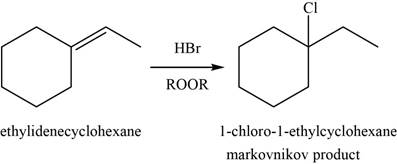
Figure 10
(g)
Interpretation:
The major product of the given reaction and the structure of any intermediate are to be predicted.
Concept introduction:
Substitution reactions are the reactions in which there is a replacement of an atom or a functional group by another atom or a functional group.
Elimination reactions are the reaction in which alkenes are prepared. In this two substituents are eliminated by either one step or two step mechanism.
(g)
Answer to Problem 8.46SP
The major product of the given reaction is shown in Figure 11.
Explanation of Solution
When an alkene reacts with peroxyacid, it forms an
The major product of the given reaction is,

Figure 11
(h)
Interpretation:
The major product of the given reaction and the structure of any intermediate are to be predicted.
Concept introduction:
Substitution reactions are the reactions in which there is a replacement of an atom or a functional group by another atom or a functional group.
Elimination reactions are the reaction in which alkenes are prepared. In this two substituents are eliminated by either one step or two step mechanism.
(h)
Answer to Problem 8.46SP
The structure of an intermediate is shown in Figure 12.
The major product of the given reaction is shown in Figure 13.
Explanation of Solution
Alkene undergoes
The structure of an intermediate is given as,
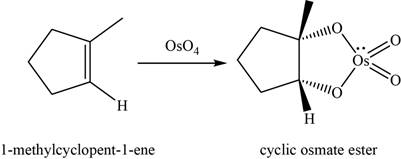
Figure 12
Now, the cyclic osmate undergoes oxidation in the presence of
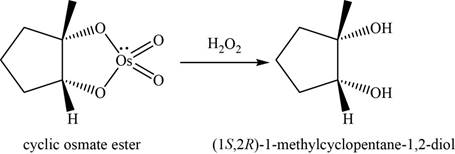
Figure 13
(i)
Interpretation:
The major product of the given reaction and the structure of any intermediate are to be predicted.
Concept introduction:
Substitution reactions are the reactions in which there is a replacement of an atom or a functional group by another atom or a functional group.
Elimination reactions are the reaction in which alkenes are prepared. In this two substituents are eliminated by either one step or two step mechanism.
(i)
Answer to Problem 8.46SP
The major product of the given reaction is shown in Figure 14.
Explanation of Solution
The major product of the given reaction is,
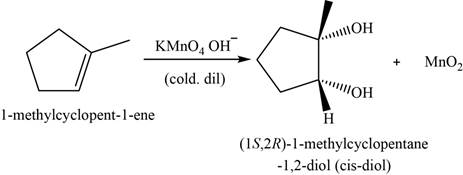
Figure 14
(j)
Interpretation:
The major product of the given reaction and the structure of any intermediate are to be predicted.
Concept introduction:
Substitution reactions are the reactions in which there is a replacement of an atom or a functional group by another atom or a functional group.
Elimination reactions are the reaction in which alkenes are prepared. In this two substituents are eliminated by either one step or two step mechanism.
(j)
Answer to Problem 8.46SP
The structure of an intermediate is shown in Figure 15.
The major product of the given reaction is shown in Figure 16.
Explanation of Solution
When an alkene reacts with peroxyacid, it forms an epoxide or oxirane. Here,
The structure of an intermediate is given as,
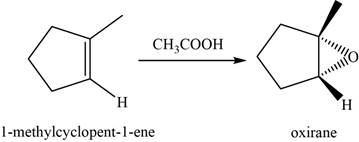
Figure 15
The oxirane is opened at more substituted carbon atom in the presence of an acid
The major product of the given reaction is,
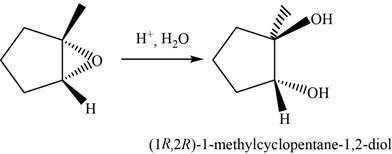
Figure 16
(k)
Interpretation:
The major product of the given reaction and the structure of any intermediate are to be predicted.
Concept introduction:
Substitution reactions are the reactions in which there is a replacement of an atom or a functional group by another atom or a functional group.
Elimination reactions are the reaction in which alkenes are prepared. In this two substituents are eliminated by either one step or two step mechanism.
(k)
Answer to Problem 8.46SP
The major product of the given reaction is shown in Figure 17.
Explanation of Solution
Alkene undergoes oxidative cleavage in the presence of hot concentrated
The major product of the given reaction is,
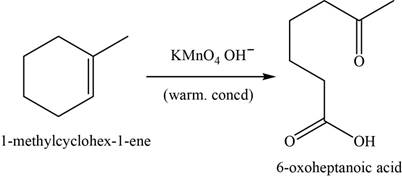
Figure 17
(l)
Interpretation:
The major product of the given reaction and the structure of any intermediate are to be predicted.
Concept introduction:
Substitution reactions are the reactions in which there is a replacement of an atom or a functional group by another atom or a functional group.
Elimination reactions are the reaction in which alkenes are prepared. In this two substituents are eliminated by either one step or two step mechanism.
(l)
Answer to Problem 8.46SP
The major product of the given reaction is shown in Figure 18.
Explanation of Solution
Alkene undergoes ozonolysis to form carbonyl compounds. Here,
The major product of the given reaction is,

Figure 18
(m)
Interpretation:
The major product of the given reaction and the structure of any intermediate are to be predicted.
Concept introduction:
Substitution reactions are the reactions in which there is a replacement of an atom or a functional group by another atom or a functional group.
Elimination reactions are the reaction in which alkenes are prepared. In this two substituents are eliminated by either one step or two step mechanism.
(m)
Answer to Problem 8.46SP
The major product of the given reaction is shown in Figure 19.
Explanation of Solution
In this reaction,
The major product of the given reaction is,
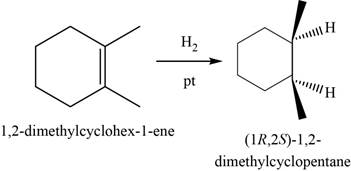
Figure 19
(n)
Interpretation:
The major product of the given reaction and the structure of any intermediate are to be predicted.
Concept introduction:
Substitution reactions are the reactions in which there is a replacement of an atom or a functional group by another atom or a functional group.
Elimination reactions are the reaction in which alkenes are prepared. In this two substituents are eliminated by either one step or two step mechanism.
(n)
Answer to Problem 8.46SP
The structure of an intermediate and the major product of the given reaction are shown in Figure 20.
Explanation of Solution
This reaction is an acid catalyzed hydration of alkene and forms
The structure of an intermediate and the major product of the given reaction is,

Figure 20
(o)
Interpretation:
The major product of the given reaction and the structure of any intermediate are to be predicted.
Concept introduction:
Substitution reactions are the reactions in which there is a replacement of an atom or a functional group by another atom or a functional group.
Elimination reactions are the reaction in which alkenes are prepared. In this two substituents are eliminated by either one step or two step mechanism.
(o)
Answer to Problem 8.46SP
The major product of the given reaction is shown in Figure 21.
Explanation of Solution
The given reaction is an olefin metathesis. The major product of the given reaction is,

Figure 21
(p)
Interpretation:
The major product of the given reaction and the structure of any intermediate are to be predicted.
Concept introduction:
Substitution reactions are the reactions in which there is a replacement of an atom or a functional group by another atom or a functional group.
Elimination reactions are the reaction in which alkenes are prepared. In this two substituents are eliminated by either one step or two step mechanism.
(p)
Answer to Problem 8.46SP
The structure of an intermediate is shown in Figure 22.
The major product of the given reaction is shown in Figure 24.
Explanation of Solution
Alkene reacts with mercuric acetate and forms mercurinium ion intermediate.
The structure of an intermediate is given as,
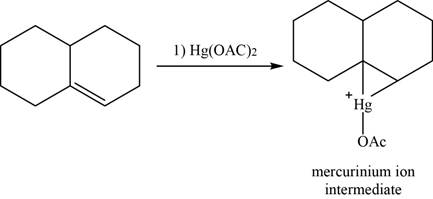
Figure 22
Now, water molecule acts as a nucleophile that opens the mercurinium ion at the most substituted carbon atom.
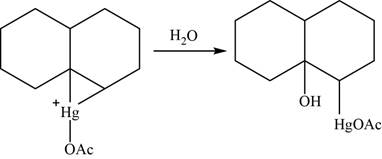
Figure 23
Now, organomercurial alcohol undergoes demercuration in the presence of
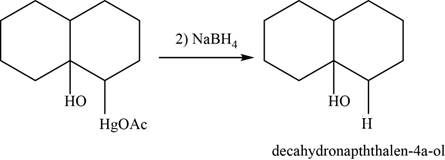
Figure 24
(q)
Interpretation:
The major product of the given reaction and the structure of any intermediate are to be predicted.
Concept introduction:
Substitution reactions are the reactions in which there is a replacement of an atom or a functional group by another atom or a functional group.
Elimination reactions are the reaction in which alkenes are prepared. In this two substituents are eliminated by either one step or two step mechanism.
(q)
Answer to Problem 8.46SP
The structure of an intermediate is shown in Figure 25.
The major product of the given reaction is shown in Figure 26.
Explanation of Solution
Alkene reacts with chlorine and forms chloronium ion intermediate.
The structure of an intermediate is given as,
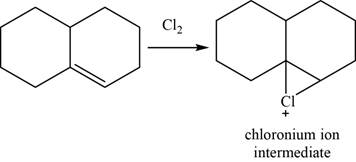
Figure 25
Now, the water molecule acts as a nucleophile that opens the chloronium ion intermediate at more substituted carbon atom. The major product of the given reaction is,
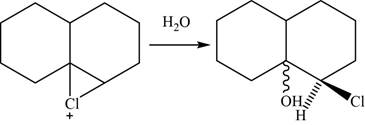
Figure 26
Want to see more full solutions like this?
Chapter 8 Solutions
ORGANIC CHEMISTRY
- Identify and provide a concise explanation of the concept of signal-to-noise ratio (SNR) in the context of chemical analysis. Provide specific examples.arrow_forwardIdentify and provide a concise explanation of a specific analytical instrument capable of detecting and quantifying trace compounds in food samples. Emphasise the instrumental capabilities relevant to trace compound analysis in the nominated food. Include the specific application name (eg: identification and quantification of mercury in salmon), outline a brief description of sample preparation procedures, and provide a summary of the obtained results from the analytical process.arrow_forwardIdentify and provide an explanation of what 'Seperation Science' is. Also describe its importance with the respect to the chemical analysis of food. Provide specific examples.arrow_forward
- 5. Propose a Synthesis for the molecule below. You may use any starting materials containing 6 carbons or less (reagents that aren't incorporated into the final molecule such as PhзP do not count towards this total, and the starting material can have whatever non-carbon functional groups you want), and any of the reactions you have learned so far in organic chemistry I, II, and III. Your final answer should show each step separately, with intermediates and conditions clearly drawn. H3C CH3arrow_forwardState the name and condensed formula of isooxazole obtained by reacting acetylacetone and hydroxylamine.arrow_forwardState the name and condensed formula of the isothiazole obtained by reacting acetylacetone and thiosemicarbazide.arrow_forward
- Provide the semi-developed formula of isooxazole obtained by reacting acetylacetone and hydroxylamine.arrow_forwardGiven a 1,3-dicarbonyl compound (R1-CO-CH2-CO-R2), indicate the formula of the compound obtaineda) if I add hydroxylamine (NH2OH) to give an isooxazole.b) if I add thiosemicarbazide (NH2-CO-NH-NH2) to give an isothiazole.arrow_forwardAn orange laser has a wavelength of 610 nm. What is the energy of this light?arrow_forward
- The molar absorptivity of a protein in water at 280 nm can be estimated within ~5-10% from its content of the amino acids tyrosine and tryptophan and from the number of disulfide linkages (R-S-S-R) between cysteine residues: Ε280 nm (M-1 cm-1) ≈ 5500 nTrp + 1490 nTyr + 125 nS-S where nTrp is the number of tryptophans, nTyr is the number of tyrosines, and nS-S is the number of disulfide linkages. The protein human serum transferrin has 678 amino acids including 8 tryptophans, 26 tyrosines, and 19 disulfide linkages. The molecular mass of the most dominant for is 79550. Predict the molar absorptivity of transferrin. Predict the absorbance of a solution that’s 1.000 g/L transferrin in a 1.000-cm-pathlength cuvet. Estimate the g/L of a transferrin solution with an absorbance of 1.50 at 280 nm.arrow_forwardIn GC, what order will the following molecules elute from the column? CH3OCH3, CH3CH2OH, C3H8, C4H10arrow_forwardBeer’s Law is A = εbc, where A is absorbance, ε is the molar absorptivity (which is specific to the compound and wavelength in the measurement), and c is concentration. The absorbance of a 2.31 × 10-5 M solution of a compound is 0.822 at a wavelength of 266 nm in a 1.00-cm cell. Calculate the molar absorptivity at 266 nm.arrow_forward
 Organic ChemistryChemistryISBN:9781305580350Author:William H. Brown, Brent L. Iverson, Eric Anslyn, Christopher S. FootePublisher:Cengage Learning
Organic ChemistryChemistryISBN:9781305580350Author:William H. Brown, Brent L. Iverson, Eric Anslyn, Christopher S. FootePublisher:Cengage Learning
 Organic Chemistry: A Guided InquiryChemistryISBN:9780618974122Author:Andrei StraumanisPublisher:Cengage Learning
Organic Chemistry: A Guided InquiryChemistryISBN:9780618974122Author:Andrei StraumanisPublisher:Cengage Learning



